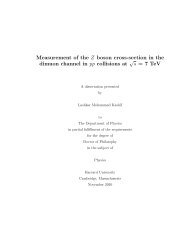2 The CDF Experiment at Fermilab Contents - Harvard University ...
2 The CDF Experiment at Fermilab Contents - Harvard University ...
2 The CDF Experiment at Fermilab Contents - Harvard University ...
Create successful ePaper yourself
Turn your PDF publications into a flip-book with our unique Google optimized e-Paper software.
Section 2: Di-Boson Production 67<br />
1. pp ! WZ with Z ! <br />
2. ~t or ~ b pair production<br />
3. pp ! Zh with h ! bb and Z ! <br />
4. pp ! qq with one hard parton going o into so-called \extra" dimensions<br />
In some cases a b-tag is called for { but not in all. A sample of events with two jets and<br />
missing energy is clearly rel<strong>at</strong>ed to the sample studied by Spiropulu & Huth in the Run I<br />
d<strong>at</strong>a, but is not the same and could contain dierence signals for New Physics. Still, the<br />
experience and in-depth understanding gained from the Run I analysis will prove invaluable<br />
for studies of this sample.<br />
In the following two sections we describe our plans for these studies in the context of<br />
di-boson production and a study of 6E T + jets.<br />
2.4.2 Di-Boson Production<br />
(Prof. Franklin, Prof. Schmitt, Dr. Burkett, Dr. Dorigo, Mr. Hall & Ms. Madrak)<br />
WW production. Madrak, Dorigo and Franklin have begun investig<strong>at</strong>ing the isol<strong>at</strong>ion<br />
of a WW signal in Run II, starting, of course, with Run I d<strong>at</strong>a. <strong>The</strong> cross section is about<br />
10 pb. An observ<strong>at</strong>ion of W + W , pairs was reported by <strong>CDF</strong> in 1996 [18], using the double<br />
leptonic topology (see Fig. 33). Although an event sample with two high P T leptons and<br />
large 6E T is very clean, this nal st<strong>at</strong>e suers from a small r<strong>at</strong>e due to the square of the<br />
branching r<strong>at</strong>io Br(W ! e; ). <strong>The</strong> nal st<strong>at</strong>e involving one hadronic and one leptonic<br />
W decay has never been observed <strong>at</strong> a hadron collider: the main hindrance is the irreducible<br />
background from single W production and two jets from gluon radi<strong>at</strong>ion in the initial st<strong>at</strong>e.<br />
This background is larger by roughly two orders of magnitude.<br />
We think it may be possible to extract some evidence for the WW ! `jj signal in<br />
Run I d<strong>at</strong>a by selecting events with a high P T lepton, 6E T , and two jets. We may study<br />
the dijet mass spectrum after the applic<strong>at</strong>ion of kinem<strong>at</strong>ical selection requirements aimed <strong>at</strong><br />
dierenti<strong>at</strong>ing the QCD radi<strong>at</strong>ion processes from the weak W decay. <strong>The</strong> tagging of charm<br />
jets may also constitute a useful tool to reduce the background. If we nd no signal in Run I<br />
we can still look forward to rening and optimizing our analysis str<strong>at</strong>egy, in order to be<br />
ready to observe a clear peak with Run II d<strong>at</strong>a.















